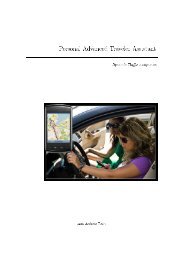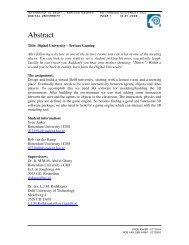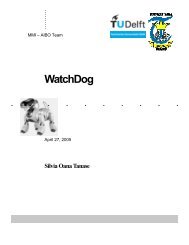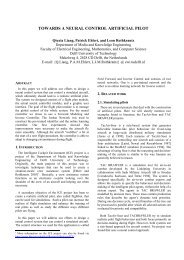Recognition of facial expressions - Knowledge Based Systems ...
Recognition of facial expressions - Knowledge Based Systems ...
Recognition of facial expressions - Knowledge Based Systems ...
You also want an ePaper? Increase the reach of your titles
YUMPU automatically turns print PDFs into web optimized ePapers that Google loves.
data taken from the Cohn-Kanade AU-Coded Facial Expression Database [Kanade et al.<br />
2000]. Some processing was done so as to extract the useful information. More than that,<br />
since the original database contained only one image having the AU code set for each<br />
display, additional coding had to be done. The Bayesian network is used to encode the<br />
dependencies among the variables. The temporal dependencies were extracted to make<br />
the system be able to properly select the right emotional expression. In this way, the<br />
system is able to overcome the performance <strong>of</strong> the previous approaches that dealt only<br />
with prototypic <strong>facial</strong> expression [Pantic, Rothkrantz 2003]. The causal relationships<br />
track the changes occurred in each <strong>facial</strong> feature and store the information regarding the<br />
variability <strong>of</strong> the data.<br />
The typical problems <strong>of</strong> expression recognition have been tackled many times through<br />
distinct methods in the past. [Wang et al. 2003] proposed a combination <strong>of</strong> a Bayesian<br />
probabilistic model and Gabor filter. [Cohen et. all 2003] introduced a Tree- Augmented-<br />
Naive Bayes (TAN) classifier for learning the feature dependencies. A common approach<br />
was based on neural networks. [de Jongh, Rothkrantz 2004] used a neural network<br />
approach for developing an online Facial Expression Dictionary as a first step in the<br />
creation <strong>of</strong> an online Nonverbal Dictionary. [Bartlett et. all 2003] used a subset <strong>of</strong> Gabor<br />
filters selected with Adaboost and trained the Support Vector Machines on the outputs.<br />
The next section describes the literature survey in the field <strong>of</strong> <strong>facial</strong> expression<br />
recognition. Subsequently, different models for the current emotion analysis system will<br />
be presented in a separate section. The next section presents the experimental results <strong>of</strong><br />
the developed system and the final section gives some discussions on the current work<br />
and proposes possible improvements.<br />
- 12 -
















